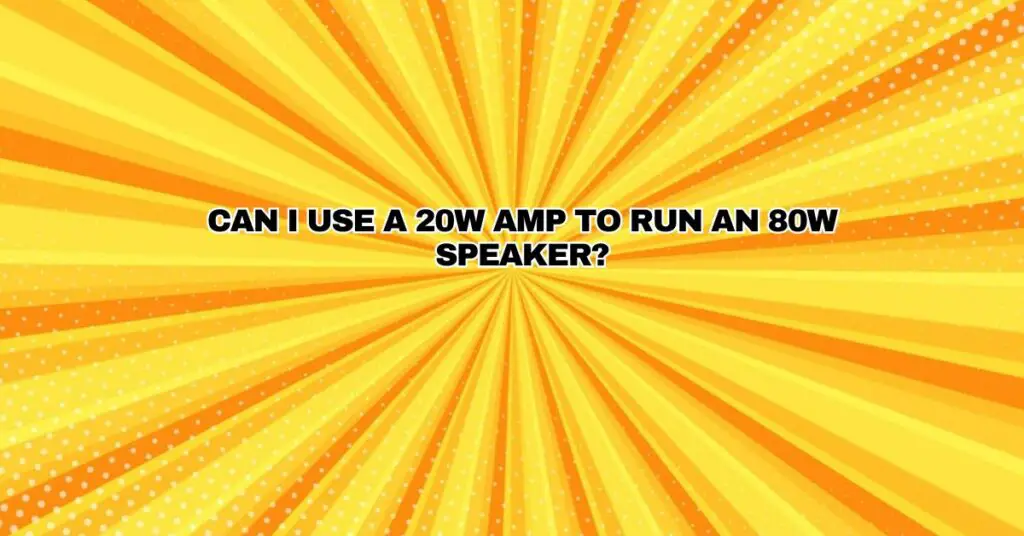Amplifier and speaker matching is a crucial aspect of setting up an audio system, and it’s essential to understand the implications of pairing an amplifier with a speaker that has a significantly higher power rating. In this comprehensive article, we will explore whether you can use a 20W amplifier to run an 80W speaker, the potential consequences of this power mismatch, and ways to mitigate any associated risks.
Understanding Amplifier and Speaker Power Ratings:
Before delving into the power mismatch scenario, it’s important to clarify the key terms and concepts:
- Amplifier Power (Wattage): This refers to the electrical power output of an amplifier, typically measured in watts (W). It denotes the amount of power an amplifier can deliver to drive connected speakers and produce sound.
- Speaker Power Handling: This represents the maximum electrical power, also measured in watts, that a speaker can handle without risk of damage. It is a critical specification that indicates a speaker’s durability and its ability to withstand the power delivered by the amplifier.
Can You Use a 20W Amp with an 80W Speaker?
The short answer is yes, you can use a 20W amplifier with an 80W speaker, but it’s essential to consider the implications and take precautions. Here’s what you need to know:
Consequences of Using an Underpowered Amplifier:
- Potential Distortion: When an amplifier is significantly underpowered for a speaker, it may struggle to provide enough power to drive the speaker properly. This can result in audible distortion, where the speaker’s voice coil may overheat and cause a harsh, unpleasant sound.
- Inadequate Volume: An underpowered amplifier may not be able to achieve the desired volume levels, especially if the 80W speaker is intended for high-output applications. This can limit the system’s overall performance.
- Risk of Overdriving the Amplifier: To compensate for the lack of power, users may be tempted to turn up the amplifier’s volume, attempting to achieve higher volume levels. This can lead to overdriving the amplifier, causing overheating and potential damage.
- Loss of Clarity and Definition: Underpowered amplifiers may struggle to provide the clarity and definition expected from speakers, particularly in the midrange and high-frequency ranges. Nuances can be lost or muddled, affecting sound quality.
- Potential Speaker Damage: Prolonged operation with an underpowered amplifier can result in speaker damage, especially if the amplifier clips frequently. Over time, this can cause voice coil overheating, cone damage, and even permanent speaker failure.
Precautions to Mitigate Power Mismatch:
If you choose to use a 20W amplifier with an 80W speaker, consider these precautions:
- Monitor Volume Levels: Be cautious about turning the volume too high. Keeping the volume within reasonable limits can help prevent distortion and amplifier overdrive.
- Use a Limiter: In professional audio settings, employ limiters to control signal peaks and prevent excessive amplifier clipping. This can protect the amplifier and speaker from damage.
- Evaluate Usage: Consider the specific usage scenario. In some cases, such as low-volume home listening, the 20W amplifier may suffice. However, for applications where higher volumes are essential, consider a more powerful amplifier.
- Speaker Sensitivity: Check the sensitivity rating of the speaker. Speakers with higher sensitivity require less power to produce the same volume as those with lower sensitivity.
- Keep an Ear on Distortion: Pay attention to any signs of distortion. If you hear distortion, it’s a signal to reduce the volume and avoid pushing the system to its limits.
Conclusion: Responsible Handling of Amplifier and Speaker Mismatch
Using a 20W amplifier with an 80W speaker is possible, but it requires careful consideration and responsible handling. The consequences of an underpowered amplifier can include distortion, inadequate volume, and potential damage to both the amplifier and speaker. It’s important to monitor volume levels, use limiters when appropriate, and take into account the usage scenario. While such a setup can work for certain applications, careful attention to the system’s performance and a willingness to adjust volume levels are key to mitigating potential issues and achieving the best possible sound quality.


